"That’s one small step for man....one giant leap for conspiracy theorists": did we really land on the Moon? HAMISH CARNACHAN investigates the controversial argument over whether NASA faked it, or whether the people pushing the theory are, themselves, loose moon units...
H
ouston, the Eagle has landed" - famous words that spelt out one of the defining moments of the twentieth century. ‘Eagle’, the Apollo 11 landing module, had gently touched down on the Moon’s surface and the United States’ National Aeronautic and Space Administration (NASA) had finally achieved what many thought was impossible. For the very first time, a craft carrying humans had visited a world other than our own planet.On a clear morning in mid-July 1969 NASA’s landmark mission began. Columbia, the command module atop a massive Saturn V rocket, successfully rose off pad 39a, thundered towards the heavens billowing a cotton-wool vapour trail and disappeared beyond the stratosphere.
The voyage to the Moon ran smoothly and on the distant side of the Moon, Eagle prepared to disengage from its mother ship.
Neil Armstrong’s voice soon crackled across the airwaves and into the headsets of the anxious technicians awaiting news back at Houston’s Mission Control. The broadcast carried the news of the successful separation: "The Eagle has wings".
The pivotal phase of the mission was underway, but when the engine on the lander was fired to begin the descent it was like triggering a signal for the drama to commence.
At 14,000 metres an alarm sounded – the computer was becoming overloaded with data – but Mission Control gave the all clear to "continue powered descent".
Moments later another siren screeched a warning. The computer readout suggested Eagle was approaching touchdown too fast. Mission Control scrambled to analyse and again snubbed the signal to abort – descent velocity was fine.
At 6400 metres above the lunar surface, and with Eagle closing at a rate of 3700 metres per minute, the time to decide whether to land or abort was almost up when Armstrong glanced out of the window and saw that they were heading directly into a boulder field.
With a landing in rough terrain impossible he manually angled the craft away, hoping to find a smoother spot to touch down. A call came through from Mission Control: "30 seconds". Fuel was running dangerously low and there was a risk that Eagle would not have enough in reserve to ascend.
Finally Buzz Aldrin’s triumphant dispatch came through: "Contact light". A collective sigh of relief was let out followed by a monumental roar that rocked the mission centre. After years of meticulous planning and four days after the mission was launched, Man was finally on the Moon.
It was 20 July, 1969, a day that is fixed in the memories of everyone who saw the flickering, grainy black and white television images of Neil Armstrong stepping down from the Apollo 11 capsule onto the lunar surface.
Arguably it was the most monumental feat in modern history – perhaps recorded history – some have even called the Apollo 11 mission the pinnacle of Man’s pioneering adventures.
So many of the people who stood witness that day were left speechless and it was Armstrong’s now famous words, "One small step for Man, one giant leap for Mankind", which articulated what they could not say themselves.
Hundreds of kilograms of samples were brought back throughout Project Apollo, as were reams and reams of film and still-photo footage. These invaluable archives and the astronauts’ experiences not only gave us an indication of how the Moon was formed and how it could be exploited in the future, but they provide evidence that set the missions in irrefutable fact.
The famous first mission to the Moon, and the five others that were to follow, were, to a majority of people, "remarkable accomplishments". For many others at the time though, the achievements were too unfathomable, incomprehensible even. They simply did not believe it was possible to put a man on the Moon.
Though there have always been subcultures that strongly believe the landings were faked, today, more than 30 years on, there is a growing wave of disbelievers who are finding favourable platforms and forums to launch attacks against the Apollo missions.
The new breed of sceptic has laid down a fierce challenge to NASA, and the space agency is now finding it increasingly harder to rid itself of the rumours that it pulled "one giant con on Mankind".
Now the conspiracy theories have been elevated to a higher level of public awareness with international television screenings of a documentary that proposed NASA faked the whole affair.
"Conspiracy Theory: Did we land on the Moon?" as the program is titled, has aired twice in the United States and in numerous countries around the world including New Zealand, creating quite a stir. While some have written it off as a "personal attack against NASA" from its creators, millions of Americans and people of other nationalities now believe that the landings were staged in a studio at the conspicuously secretive Area 51 military base in the Nevada Desert.
One of the spin-offs of the film is that Internet conspiracy sites have since flourished and now provide an inexpensive global medium for sceptics to push their position. They seem to have made substantial headway, and the level of debate on the topic has become unprecedented.
In October this year, a Washington newspaper report suggested that the argument was getting ugly too. The Daily News ran a story alleging that one sceptic confronted 72 year old former astronaut Buzz Aldrin, poked him, verbally abused him and demanded that he swear on the Bible that he really walked on the Moon. Aldrin supposedly responded by punching Bart Sibrel in the face.
So what is behind this recent groundswell of contention? As more and more people noticeably start to query NASA’s moon landings is there actually some substance to their doubts? Do the Apollo missions really deserve the highest accolades or were they, as the sceptics claim, an elaborate hoax staged right here on Earth?
Sibrel, who was four years old when man first set foot on the Moon, is one of the growing numbers of detractors who have made it their own personal goal to prove that the landings were the biggest con job in history.
Central to the stance that sceptics like Sibrel have adopted is that the landings were staged to dupe the Soviet Union – it was the height of the Cold War and the United States had entered into an aggressive space race with their old foe.
On his website (moonmovie.com), Sibrel lists the grounds on which he has taken issue with what has generally been regarded as established fact, and claims to have found a credible source who worked for the space program during the 1960s to back these up.
"He asserted, most confidently, that the Apollo moon landings were, first, impossible and, second, falsified as a Cold War tactic to bluff the Soviet Union into thinking the United States had greater capability than it really did," states Sibrel.
"I discovered that the highest ranking official at NASA resigned, without explanation, just days before the first Apollo mission. All three crewmembers of the first historic flight also resigned shortly thereafter.
"Neil Armstrong, the most famous astronaut because of supposedly being the first man on the Moon, refused to even appear in a single still picture on the Moon! Aside from the initial press conference immediately following the event, in which he seems very disgruntled, he has not given a single interview on the subject, in print or on camera, to anyone ever!"
History notes that Sibrel is indeed correct in these claims. However, is it rational to argue, with absolute certainty, that a solitary testimony from a retired NASA employee and a handful of resignations are anything other than coincidence?
Well, Sibrel asserts that there is more evidence to back up his allegations and on his website he lists his ‘Top Ten’ reasons why the landings were a hoax and why Man has never set foot on the Moon.
S
ceptics have literally cre-ated a field of study in the dissemination and scrutiny of NASA material and typical of their contentions are some of the following points, often shown as proof that there were no moon landings.Richard Nixon, the king of cover-up, was the President at the time and sceptics query his potential antics that were never discovered. They argue that a successful manned mission to the Moon offered a spirit-lifting distraction for American citizens smarting over 50,000 deaths in the Vietnam War.
It is also argued that the Soviet Union was well ahead of the US in the Cold War space-race. They had a five-to-one superiority over the States in terms of manned hours in space and were the first to achieve important milestones such as launching the first man-made satellite into Earth’s orbit, putting the first astronaut in space, putting the first astronaut in orbit around Earth, and completing the first space walk.
Detractors say this put America at a perceived military disadvantage in missile technology and because they were so far behind in technical capability they had no other alternative but to fake it.
There is the fact that passengers of a spacecraft that went beyond Earth’s orbit would likely have been subjected to the potentially lethal radiation of the Van Allen radiation belt. Questions are raised about the possibility of astronauts travelling through the field unscathed.
Sibrel suggests it is odd that "the Apollo missions were the only times ever that an astronaut, Soviet or American, left the safety of Earth’s orbit and ventured into the deadly hazards of space radiation."
Also peculiar, says Sibrel, is the astronauts’ silence on their mission.
"Neil Armstrong, the first man to supposedly walk on the Moon, refuses to give interviews to anyone on the subject. Collins also refuses to be interviewed. Aldrin, who granted an interview, threatened to sue us if we showed it [Sibrel’s own documentary, "A Funny Thing Happened on the way to the Moon"] to anyone."
Another significant point of conflict is held in the photographs and film taken on the Moon. On close inspection, analysts have discovered that there are numerous inconsistencies and oddities. For example, no stars are shown in any of the film and the shadows do not fall in the same direction. To some this suggests that the footage was shot in a studio under artificial lighting.
"Sunlight would cast shadows that would never intersect," argues Sibrel.
The Hasselblad cameras that were used by NASA on the missions had many crosshairs in each frame. Keen-eyed sceptics have noticed that in some shots the crosses disappear behind objects in the picture, providing further proof of foolery.
Perhaps even more bizarre are the pictures with identical backgrounds that are supposed to have been taken at different locations on different days. In two sequences from the Apollo 16 mission, this irregularity is clearly depicted.
But the biggest discrepancy and the "ultimate give away", according to the sceptics, is the footage that shows the American flag fluttering in the wind – an impossible phenomenon on the Moon simply because no wind can form in the vacuum of outer-space.
"The wind was probably caused by intense air-conditioning used to cool the astronauts in their lightened, un-circulated space suits. The cooling systems in the backpacks would have been removed to lighten the load not designed for Earth’s six times heavier gravity, otherwise they might have fallen over," suggests Sibrel.
S
ibrel has spent many years and almost US$500,000 in a quest to prove his theory that the landings were faked. But aside from querying inconsistencies and highlighting unexplained oddities, he professes to have uncovered irrefutable evidence."In my research at NASA I uncovered, deep in the archives, one mislabelled reel from the Apollo 11, first mission, to the Moon. What is on the reel and on the label are completely different. I suspect an editor put the wrong label on the tape 33 years ago and no reporter ever had the motive to be as thorough as I. It contains an hour of rare, unedited, colour television footage that is dated by NASA’s own atomic clock three days into the flight.
"Identified on camera are Neil Armstrong, Edwin "Buzz" Aldrin, and Michael Collins. They are doing multiple takes of a single shot of the mission, from which only about ten seconds was ever broadcast. Because I have uncovered the original unedited version, mistakenly not destroyed, the photography proves to be a clever forgery. Really! It means they did not walk on the Moon!"
In a book he released last year, amateur French astronomer and photographer Philippe Lheureux made international headlines when he made similar claims about NASA faking photographic footage.
But Lheureux puts a different spin on the hoax theory. In ‘Lumieres sur la Lune’ (Lights on the Moon) he suggests astronauts did get to the Moon but in order to prevent competitors from using sensitive scientific information in the genuine photos, NASA released bogus images.
The BBC quoted Lheuruex from French television: "In order not to give out scientific information they released photos taken during the training stages.
"That satisfied the American taxpayer and that left no real possibility for other countries to make scientific use of them."
Lheureux presents evidence from a photo of a lunar landing craft’s ‘foot’ because it is totally dust-free. The problem here, he says, is that according to Neil Armstrong large clouds of dust were displaced on landing.
Need more proof? How about props in space? According to the BBC report,
Lheureux says that when one of the photos purportedly taken on the Moon is enlarged a
letter ‘C’ can clearly be seen scribed on a rock "exactly like some cinema
props".
Sibrel alleges that NASA continues to doctor their film footage to clean up obvious errors
like those that Lheureux claims to have exposed.
"Newly retouched photographs correct errors from previously released versions. Why would they be updating 30-year-old pictures if they really went to the Moon?" asks Sibrel.
In the face of this barrage, NASA’s persisting silence does not seem to have helped quell any of the doubts either.
In response to Lheureux’s claims, the agency was reported to acknowledge that about 20 pictures of the thousands that were taken do take some explaining but on close examination they have a scientific explanation. NASA left its response at that.
In the past NASA has either relied on information sheets originally issued in 1977, or private citizens, concerned enough to mount their own campaigns to address some of the concerns in circulation.
But in late 2002 it seemed that the US space agency had finally got fed up with all the dissent. They commissioned James Oberg, a 22-year Mission Control veteran and prominent space-travel author, to work on a 30,000-word book to debunk the faked landing hypothesis and also examine how such theories become popular and spread.
The former chief historian at NASA, Roger Launius, conceived the idea to give schoolteachers a tool to help answer classroom queries because half the world’s population was not yet born the last time an astronaut reached the Moon.
"As time progresses, this gets less and less real to everybody. At some level, I think that may be what’s happening here," Launius told Washington’s Daily News.
However, days after they announced the funding for the book, NASA added fuel to the fire by pulling its financial backing. According to the worldwide news service, AFP, a NASA spokesman said the project had lost its focus because it was "being portrayed by the media as a PR campaign to debunk the hoaxers and that was never the intent".
Oberg has lost his promised US$15,000 contract for the work, but despite this setback he informs Investigate that he is forging ahead with the book, writing it "commercially".
Until Oberg completes the book though, the task of silencing the critics will be left to individuals like Dr. Phil Plait, a teacher of physics and astronomy at Sonoma State University in California. Plait, who has no links to NASA, invests his own resources in disseminating information he believes categorically disproves the conspiracy theories.
And just as the sceptics are using the Internet to spread their message, so too is Plait on his ‘Bad Astronomy’ website (www.badastronomy.com). In times when public opinion is so easily influenced by the Internet and "subjective" television programming, he says he created the site to add balance to a growing argument.
"Am I a bad astronomer?" asks Plait. "I don’t think so. I would say I am an average one. But on these web pages, I’m discussing astronomy that is bad."
A good part of this discussion is a detailed rebuttal of Fox television’s "Conspiracy Theory" documentary in which Plait assures that the rumours broadcast on the network are completely false, some laughably so.
"Sometimes, I think I have heard everything when it comes to bad astronomy. Then something comes along so strikingly nuts that I have to wonder what still lies ahead. In this case, the craziness involves people who think that the NASA Apollo missions were faked."
The "craziness" Plait refers to has grasped a sizeable chunk of the American population too. Although the documentary states that 20 percent of Americans now doubt that Man set foot on the Moon, the claim, like many of the others, is actually false. The real figure, sourced from a 1999 Gallup-poll, is closer to 6 percent.
Some call this slice of the population the "lunatic fringe" but, nonetheless, 6 percent of almost three hundred million, is still a significant body of outsiders. Still, Plait isn’t fazed by the foibles of his countrymen.
"There is no idea on God’s green Earth so dumb that you can’t get a big chunk of the American public to buy it. These are the same people who believe you can cut taxes but expand services, and who believe you can extract oil from the ground indefinitely without running out of it."
On his site he proposes that part of the problem creating the current wave of doubt is a lack of understanding of science. Plait doesn’t profess to have covered every claim by the conspiracy theorists, simply because there are so many, but he does answer many of the major "myths". He says some involve subtle, but comprehensible, physics, while lesser assertions are easily shown to be false.
For example, he readily acknowledges that the US flag is moving but says the explanation is entirely logical.
"The flag had a stiffening rod on the upper side so it would stand out from the staff. When the astronauts moved the pole, the free corner lagged behind by simple inertia. The flag actually flops unnaturally quickly because there is no air resistance to impede it."
As far as the absence of stars in the footage goes, claimed by sceptics to be indicative of filming inside a studio, Plait reasons that basic photography clears this contention.
He says that because the Apollo astronauts all landed on the ‘day’ side of the Moon, and all the film they shot from orbit were over the ‘day’ side, the exposure settings were all set for daylight.
"Set your camera to 1/125 at f/8 (a setting typical of the slower films in use in 1969). Aim it at the night sky and shoot pictures. Tell me how many stars you see. Aim your camcorder at the sky and see how many stars you can film.
"Even with the eye you’d have difficulty seeing stars from the daytime lunar surface unless you stood in a shadow and shielded yourself from any light reflected from the ground, for the same reason you can’t see stars from a brightly lit parking lot at night."
B
ut sceptics also assert that con-verging shadows in numerous pictures provide further evidence that the landings were staged inside, under artificial lighting. As Plait has already indicated, this is one of those issues that requires a little scientific understanding."Shadows lie on parallel lines pointing away from the Sun. Because of perspective, they will appear to radiate away from the point on the horizon directly under the Sun. It’s simply incredible that people who claimed to have backgrounds in photography and engineering would not know this.
"A brief look around outdoors on a sunny day will show that shadows of nearby objects do not line up with more distant ones, or even point directly away from the Sun. The reason is that you don’t line up the base of the object with its shadow. You draw a line from a point on the edge of the shadow through the object that casts that part of the shadow. So it’s simply ridiculous to draw lines from the base of the lunar module through its shadow. To see if the shadows were consistent, you’d have to draw lines from objects on the lunar module to their corresponding shadows. These lines should converge on the Sun."
One sequence in the program that Plait appears to take pride in ripping apart quite convincingly shows that two scenes supposedly filmed on different days at different locations were actually filmed at the same spot.
"Maybe this proves the missions were filmed on Earth on a set. Or maybe it merely shows that whoever edited the film mixed up the footage," says Plait who suggests the logical explanation would make no sense at all to a conspiracy theorist.
Another couple of photos show that crosshairs etched on the camera lens appear to be behind objects in the foreground. There’s no question about it - the crosshairs do disappear at the edge of the objects. One in particular appears to be in front of the American flag but behind an astronaut’s arm.
"If you’re going to stage the landings on Earth, why put crosshairs on the camera at all? If we assume the photos were shot with the calibrated cameras that would have gone to the Moon, and NASA went to the time and trouble to build stage sets and have people in spacesuits act out the landings, why not just shoot the scenes you need? Cutting and pasting makes no sense at all - nobody would have missed the apparently doctored shots if they weren’t made."
Plait says somebody editing out distracting crosshairs for press release makes perfect sense, or another feasible explanation is that areas of brighter light in the picture may simply have hidden the marks.
French cynic Lheureux claims the absence of dust on the foot of the Eagle landing craft proves some pictures were faked. "Not so" in this case says Plait – it is merely a case of confusing lunar dust with household dust.
"Household dust is mostly organic (a lot of it is dead skin). It has a low density and floats easily in the air. Lunar dust is powdered rock, much higher in density and with no air to support it. There are no dust bunnies [eddies] on the Moon.
"Kick any dry, bare ground surface on Earth and you will kick up rock dust. Kick the Moon and you will kick up lunar dust. Both kinds of dust are powdered rock, different origins but with somewhat similar properties. Rock dust is pretty cohesive once it packs down. One reader sent in a picture of the lunar rover churning up dust and asked how this could happen if there is no dust on the Moon. Same way an ATV in a gravel pit kicks up dust. Nobody ever said there is "no dust" on the Moon, just no fluffy, easily mobilized dust.
"Once the lunar lander rockets blew away the near-surface dust, what’s left? Larger particles too big to move easily."
The ability of NASA astronauts surviving passage through the extreme radiation of the phenomenon known as the Van Allen radiation belt takes some explaining and Plait offers detailed analysis on his website.
In very simple terms, because they passed through the belt at such a rapid speed, the astronauts spent less than 15 minutes in the danger zone. Plait calculates that exposure over that amount of time would have been about 1 percent of a fatal radiation dose – perhaps not completely safe but entirely survivable.
Finally, it is well known that America was losing the space race to the Soviet Union. In one of the most famous speeches of his presidential career, John F. Kennedy acknowledged this and pledged support and billions of dollars of funding to match the Russian’s strides in space: "I believe this nation should commit itself to achieving the goal, before this decade is out, of landing a man on the Moon and returning him safely to Earth."
Of course history tells us that Kennedy did not survive to see his vision fulfilled and it was the infamous Richard Nixon who was in power when NASA finally accomplished the goal. But for some sceptics it would not have been above Nixon to pull a lunar landing scam.
However, why would the President have gone to the trouble of preparing a contingency speech to be read to the watching world if the mission failed and the astronauts died?
In 1999 the BBC reported that a memo found in America’s national archives revealed the extent of emergency planning for the first mission by NASA and the Whitehouse.
Radio transmissions would supposedly have been terminated, leaving the space travellers to die or commit suicide in silence. Nixon’s speech would have opened: "Fate has ordained that the men who went to the Moon to explore in peace will stay on the Moon to rest in peace."
Is this irrefutable evidence that Man did reach the Moon, or another prop in an elaborate hoax?
Perhaps the AFP news service is correct when it suggests that by staying silent, NASA merely feeds the hoax rumours; by denying, it encourages charges over an establishment cover-up – the agency appears to be in a no win situation.
Sceptics like Bart Sibrel point to a human condition called "cognitive dissonance", a condition when someone has a long held belief so deeply rooted in their psyche that they cannot see anything else, even if visible facts present themselves that prove contrary to their belief.
"The pride inducing moon landings can certainly cloud some people from seeing the distasteful truth," he states.
Meanwhile, Plait will not reply to queries that do not firstly address his own: What evidence would it take (available now on Earth) to prove we really went to the Moon? He suggests cognitive dissonance should work both ways.
"I have found it to be a great general-purpose cut-through-the-crap question to determine whether somebody is interested in serious intellectual inquiry or just playing mind games," says Plait.
With such resolute opponents facing off, which side of the story are we supposed to believe? Will we ever really know, with absolute certainty, whether Man reached the Moon or not?
Well, the answer may be closer than many think. European scientific astronomers have announced that they will use the latest, and most powerful, telescope ever made to search for equipment NASA astronauts left on the Moon.
It is hoped that the Very Large Telescope (VLT), capable of imaging a human hair from 16 kilometres away, will provide visual confirmation of one or more of the six lunar modules that landed on the Moon.
Across the Atlantic, Californian company TransOrbital plans to mount a search for further proof. Trailblazer will be the first commercial probe to orbit over one of the Apollo landing sites and take photos of gear left behind by NASA. The launch of Trailblazer has been tentatively scheduled for August 2003.
Certainly such technological developments will have set alarm bells ringing already.
"Sceptics, you may have a problem."
.
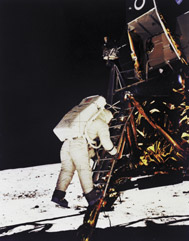
OTHER STORIES:
Contents (PDF)
The New Powerbrokers
Free Speech
But Is It Cricket?
Let Slip The Dogs Of War
BUY THIS ISSUE
COMMENT & DISCUSSION BOARDS
Newstalk
Intelligent Design
Healthtalk
Parenttalk

conspiracy theory problem no. 1: in 1969 there were no computerised photo-editing
programmes. forging photographs was strictly a cut and paste job. if we never got to the
moon, who took these pictures on kodak extachrome film. this is not fuzzy broadcast video,
this is hard copy colour film, with a small earth in the background. who got far enough
out in space to take a picture of a small earth and a large moon? to put it in
perspective, more computing grunt is required to create this magazine than was used in the
apollo programme
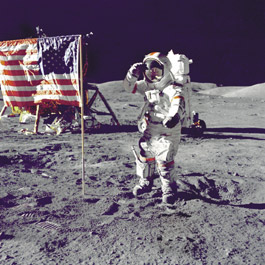
conspiracy theory problem no 2: if it had been filmed in a studio, multiple
light sources would be required to evenly fill such a large background, yet only one
source exists in this photo. additionally, if the light source were man-made then it would
have to be so close that shadows would be seen radiating in different directions
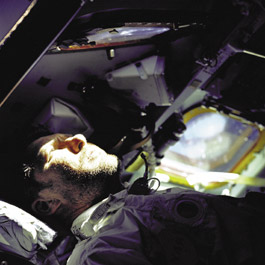
conspiracy theory problem no. 3: if we faked the first trip to the moon because
we couldn’t do it, why compound the risk of discovery by faking several more moon
landings in quick succession? why not quit while they’re ahead? why fake the apollo
13 crisis?
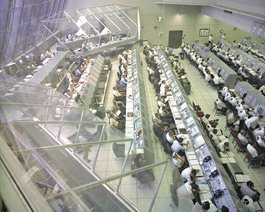
conspiracy theory problem no. 4: hundreds of thousands of people worked on the
apollo flights, each performing detailed technical tasks, each expecting certain data on
the screens in front of them. to fabricate that data and fool all the people involved
would probably be a larger technical problem than actually getting to the moon in the
first place
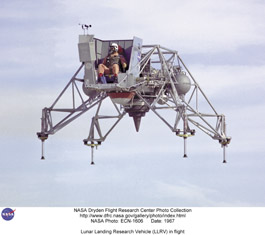
conspiracy theory problem no. 5: contrary to the claims in the documentary that
it was only test flown once, and crashed, three lunar module prototypes were test flown on
earth more than 160 times